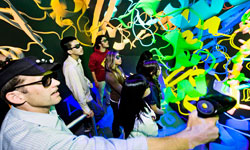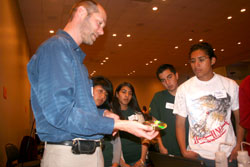High School Students Get The Big Picture on Nanotechnology
Andrea Siedsma | April 6, 2009

Jeff Milton, founder of Torrey Path LLC, gives San Diego high school students a virtual tour inside a molecule inside the StarCAVE at Calit2 at UC San Diego. Photo Credit: Erik Jepsen/Calit2
From hair gel to virtual gene expression, Southern California high school students got the “big” picture on nanotechnology at UC San Diego Wednesday.
About 175 students participated in hands-on nanotechnology experiments such as exploring ways of creating color with shapes, a virtual walk inside a molecule, and a view of the world’s smallest motors. The “Small Wonders” event was part of the inaugural San Diego Science Festival.
During Small Wonders, students saw atoms and molecules like they never have before as they put on 3D sunglasses and stepped inside the Calit2 StarCAVE on cmapus. The StarCAVE is a five-sided virtual reality room where scientific models and animations are projected in stereo on 360-degree screens surrounding the viewer. On this day, Jeff Milton, founder of San Diego-based Torrey Path LLC, was the StarCAVE guide. He used the state-of-the-art computer visualization technology to show the students a Nobel Prize-winning model of a gene in action, as well as the inner workings of an HIV drug.
“What we’re looking at is a protein…it’s called a green fluorescent protein,” Milton explained to a handful of students. “This experiment was done by a professor here who just won the Nobel Prize, Roger Tsien. His lab is not very far from where we are standing right now.”

Michael Sailor, a UC San Diego professor of chemistry and biochemistry, bioengineering and nanoengineering, shows students how colors are mimicked on a CD as part of a nano structures demonstration.
After the StarCAVE tour, some of the students went back to the Price Center to discover more of the nano world. One of those discoveries was learning the tricks that beetles, butterflies and abalone shells use to get their colors. During this hands-on demonstration, students worked with a photonic crystal made on a silicon chip that mimics these natural nanostructures, and learned how to build a color-changing nanosensor that can detect materials such as pollution.
“Many of the students here haven’t really been exposed to this type of science,” said presenter Michael Sailor, a professor of chemistry and biochemistry, bioengineering and nanoengineernig. “This is a demonstration on nano structure materials that have particular colors, much like colors that are in an abalone shell. We are showing the students that we can make chemical sensors out of these materials and do things like sense pollutants in the environment.”
Jordan Hernandez, a 16-year-old high school student who was at the Small Wonders event though Pasadena City College’s Math/Science Upward Bound program, was intrigued by the field of nanotechnology as she and a classmate used a heat gun to change the form of a thin piece of metal.
“This is something that we usually don’t get exposure to so it’s cool to have this opportunity,” Hernandez said.
The Math/ScienceUpward Bound is a pre-college program funded by the U.S. Department of Education designed to encourage scholars from low-income families and/or whose parents did not graduate from a four-year college to develop the skills and motivation necessary for success in college and beyond.
“These students who come from low-income families and who are first-generation college-bound students don’t realize there is such a great diversity in the math and science fields,’ said Joy Brittain, director of the Math/Science Upward Bound program at Pasadena City College. “By coming to events like this one, they are able to see all the opportunities in engineering. They see that it’s not only doable but that it’s fun.”
Brittain said that events like Small Wonders also pave the way for future homegrown tech workers. “There has been all this talk about the United States losing technology workers to other countries,” she said. “There is great potential for these low income students to become future engineers or doctors or technology leaders right here in this country.”
During the lunch break, Benjamin Ang, an 11th-grader at San Diego High School, was more than eager to talk about his experience at the Small Wonders event. “I’ve always been interested in chemistry but now I’m even more interested,” Ang said. “I’m learning some really cool stuff today. Right now there are all these small branches of science. In 5 to 10 years from now, we may be experimenting with even smaller technologies.”
At one of the Small Wonders demonstration tables, Allison Finger and Caitlin Buckspan, both Ph.D. bioengineering students at UC San Diego, used products like hair gel and diapers to show the physics and chemistry behind smart materials, and how they respond to external stimuli.
“We want these students to know that there’s this huge field in polymers that they could go into,” said Finger, who works in bioengineering and nanoengineering professor Shyni Varghese’s lab. “For me, as a woman, it’s important to also encourage other women to be involved in math and science. They usually don’t get that motivation from other outside sources. If they see other women doing research, it will inspire them.”
Inspiration was one of the themes of the Small Wonders event. Larry Bock, executive director of the San Diego Science Festival, said new and exciting fields like nanoengineering help fuel interest in science among young students.
“It’s hard to wow kids these days,” Bock said. “Nanotechnology allows us to have a lot of cool, hands-on activities and show these kids something they’re never seen before.”
Besides hands-on experiments and demonstrations, students participated in a Q&A with Nobel Laureate and American chemist Robert Grubbs, and watched the award-winning short film, “When Things Get Small.”
Bock said UC San Diego is the perfect venue for such an event.
“There’s no place in San Diego accept for UC San Diego where we can get people to volunteer their time, have a Nobel Laureate here, have National Academy of Sciences members, and facilities like Calit2’s StarCAVE,” Bock said.
“San Diego is a unique place because it’s a science city,” he added. “But most people have no clue about what goes on in a place like UCSD and this whole La Jolla mesa area. Whether people are interested in science or if they are taxpayers, we have to inform them of what we’re doing. They need to see how important science is.”

|